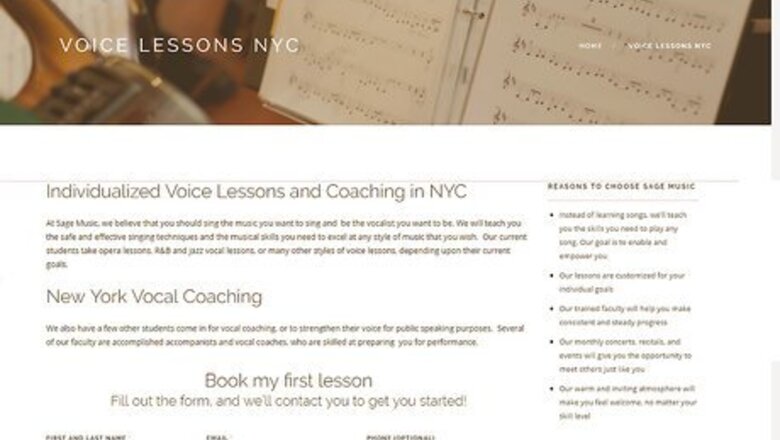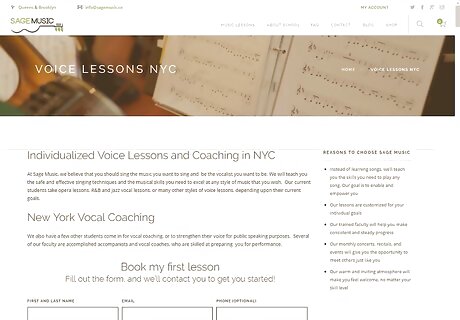
views
Taking Singing Lessons

Search online for vocal teachers. The best way to learn how to sing bass is by taking voice lessons. Search online for vocal teachers in your area. For example, search for “voice teachers in New York City.”

Evaluate the teacher. Not all voice teachers will be suitable for a bass singer. Ask the teacher if they have experience working with or training bass vocalists. The best teachers can typically work with a wide range of singers. You also want a teacher who focuses on teaching vocal techniques, not just songs and repertoire. Avoid a teacher who only works with one type of vocalist.

Take in-person vocal lessons. If you have found a suitable teacher in your area, try taking in-person voice lessons. Explain to the instructor that you are interested in learning how to sing bass and that you want to work on techniques to help you develop the lower range of your voice. Voice lessons typically cost between $30 and $75 dollars for a half-hour session.

Consider online vocal lessons. In some instances you may not be able to find an appropriate voice teacher close by. Instead, try taking vocal lessons online. There are lots of instructors who will teach one-on-one classes completely online using webcams.
Practicing Bass Techniques

Identify your vocal range. Have your vocal instructor play a range of notes on the piano in ascending and descending order. Try and mimic the notes until you reach a note that's beyond your range. This will allow you to identify your range. Alternatively, you can download an application that can help determine your range. When you are first learning to sing bass, your range is typically low. For instance, you may only be able to sing a middle-range octave with a few notes on either side. Your voice's pitch when conversing is often towards the lower end of your vocal range.

Work to expand your range. A bass vocalist should be able to comfortably sing the notes C2 to E4. Work with your vocal teacher to expand your range so that you can sing these notes. Focus particularly on creating an even tone for each note. Try singing scales at the lower end of your range that you are comfortable with and then gradually go lower. Practice these scales daily. To increase the lower end of your vocal range, you also want to think about relaxing your voice rather than moving towards vocal fry as an alternative to a deeper sound.

Sing from the chest. Bass singers typically sing with a chest voice instead of a head voice. This means that the sound resonates lower in the mouth and chest. The sound is often deeper and less breathy than your head voice. In order to practice chest voice singing, try talking first and then transition into singing. For example, try repeating the words uh-oh while singing a variety of different notes. You can also place your hand on your chest while singing in order to feel the vibrations. This will help you determine when you are singing from the chest.

Practice rounding your vowels. Some bass singers will develop a vocal wobble. This is a result of singing wide open and not rounding the vowels. In order to prevent vocal wobbles, you should practice creating rounded vowels. Keep your mouth round while singing a variety of different vowels. For example, sing the word "more" while completing a scale of notes. You can also try singing "me" while keeping a rounded mouth.

Listen to other bass singers. When you are learning to sing bass, it is important that you listen to other bass singers. This will help you develop an ear for bass vocals and can help to inspire your own voice. For example, try listening to Barry White or Isaac Hayes.
Maintaining Proper Posture and Breathing

Keep your knees and hips relaxed. When you are singing bass your knees and hips should be neither locked nor bent. Instead, they should be loose and relaxed. Your pelvis should be positioned over your feet. This positioning will help to optimize your vocal abilities.

Keep your chin parallel to the floor. You also want to make sure that your head is in the right position for singing. Your chin should be parallel to the floor and your ears should be directly over your shoulders. Many people have a tendency to hold their head too far forward. This can create pressure in your throat that will impact the quality of your voice. In most cases improper head positioning is a result of an overly arched back.

Practice breathing exercises. In order to sing bass, you need to learn how to breathe properly from your diaphragm. Try lying on your back and resting your hands on your waist with your fingers pointing towards your belly button. Then, fill up your stomach with air by taking a slow and deep breath. You should be able to feel your hands rise and fall with each deep breath. Breath in and then exhale while counting to five. Do this ten times, making sure that your hands rise and fall with each breath. Repeat the exercise twice daily.

Take small breaths while singing. One common problem for bass singers is over-breathing. By taking too much air a singer is forced to use their tongue to cap their breath causing pressure. Instead, you should take small breaths while singing and release the breath slowly.
















Comments
0 comment